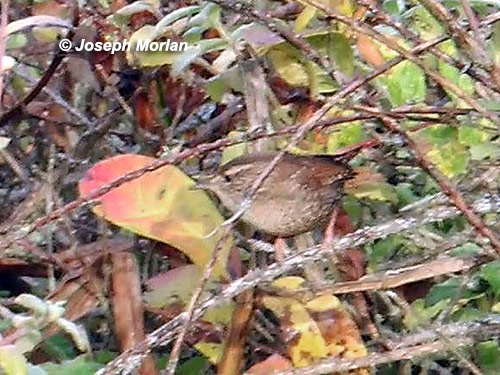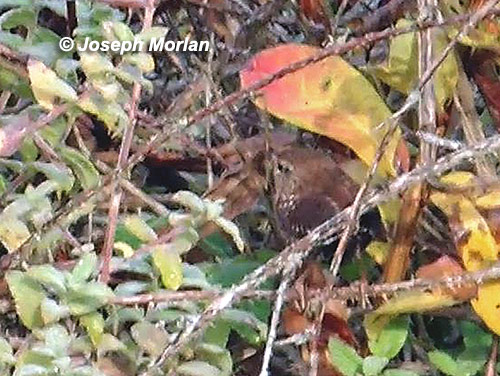
Video-grab showing the overall pale color of the underparts and face.
Winter Wren (Troglodytes hiemalis)
Tomales Bay Ecological Reserve, Inverness Park,
Marin Co, CA
18 November 2013
Joseph Morlan
Photos © 18 November 2013 by Joseph Morlan. All rights reserved.

Video-grab showing the overall pale color of the underparts and face.
This species was reportedly found here by Todd Easterla on 15 November. This morning Dan Singer and I decided to try for the bird. Soon after we arrived at about 8:15am Dan heard the bird chipping deep in the willow thicket. We waited by an opening in the willows and were treated to brief views of the calling bird in a clump of blackberry bramble along a fence between the two willow clumps. I tried to record the vocalizations using the video mode on my camera and obtained a brief video of the bird. I extracted three still images from the video and posted them here. However Dan got much better photos. My video grabs seem to have a pinkish cast which is photographic artifact. Dan's photos show the colors much better. Also the photos posted by Jules Evens and Michael Parks are much better and more accurate. Links below.
All too quickly the bird moved away towards the street where we could hear it calling. There seemed to be two types of calls, one a typical call which is lower pitched than that of Pacific Wren (Troglodytes pacificus) and a very rapid trill which sounds like a ratchet. I have posted clips of these vocalizations associated with their sonograms below. It appears from the sonograms that both of these vocalizations are variations on the same call. The ratchet call is just faster with a machine-gun cadence. Note that Dan's camera shutter is recorded on the first clip. In addition, the bird sang once, with a simpler more musical song, compared to Pacific Wren.

Showing contrast between the grayish crown and browner mantle. Note bold flank pattern.
Description
The following description is based on memory and on photos:
A tiny compact wren, closely resembling the Pacific Wren (Troglodytes pacificus) but decidedly paler particularly on the throat, belly and supercilium. The flanks showed more striking contrast with a mixture of black and white spotting. The wings had obvious white spots lacking the strong buff tones usually present on Pacific Wren. The crown seemed to be grayer than the back. The strongest rusty brown coloration was on the wing coverts and tail. The bill was very thin and seemed slightly longer than that of Pacific Wren. The tail was very short, occasionally cocked and barred with black. The feet and legs were bright pink.

Video-grab showing strongly contrasting white spots on the wing.
Discussion
Status in California
This species was considered conspecific with the Pacific Wren until split in the 51st supplement of the AOU Checklist (July 2010). Currently, the CBRC has accepted 10 records of Winter Wren, all from late Fall and Winter. An additional six records were not accepted. Click here (page 42) for a full listing of past records.
Identification
Identification criteria are still being worked out. David Sibley has a useful article here
and Nathan Pieplow has posted an excellent summary along
with critical recordings of vocalizations. This bird seems to fit the features suggested by Sibley and the vocalizations
seem to have a sparrow-like quality consistent with what has been reported for Winter Wren.
High Resolution Sonograms
Rapid ratchet-like call-notes recorded from video. Click on Waveform/Spectrogram image to hear sound